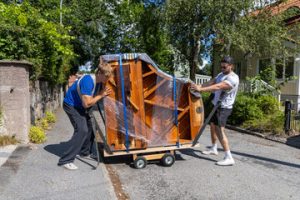For antiquities, preserving them means more than just protecting them from damage. It also requires preserving their context.

The inscriptions on antiquities provide information about people, events and dates from the past. They help historians learn more about the daily lives of ancient people and can also shed light on the way in which the occupants of different cultural areas perceived their world. Inscriptions on Antichità Napoli can be extremely useful to researchers and can often help them solve mysteries about artefacts.
Inscriptions on antiquities can be written in many languages and can offer important clues to the history of an object. Inscriptions can be found on tombstones, ossuaries and even buildings. They can contain names, dates, and phrases expressing sentiments. The inscriptions on antiquities can help in determining the origin, age and identity of an object.
Some inscriptions can also provide clues about how an object was used in the past. For example, if an ossuary contains the name of a famous person, it might have been used to hold that person’s bones. Other inscriptions may tell us more about the occupant’s family or social status. Inscriptions on antiquities can provide a lot of information about the culture and religion of an object’s owner.
For example, a recent study on an ossuary found at Jamestown in the US Virgin Islands has revealed that the inscription refers to a man named Jesus. The researchers say the inscription is likely to have been a personal one and that it was probably inscribed by someone who knew Jesus’ brother, Joseph, or another relative of his. They also uncovered evidence that the stone was used for burial in the first century, which is when the biblical story of Jesus’s life takes place.
The follow-up project >>Archaeological contexts of inscriptions in the domestic sphere (Turkey, Cyprus) will study inscriptions that appear on objects that were kept at home, rather than at public places. This will allow them to explore more deeply questions about how the inscriptions were used, for whom and why, and how they differed from one house to the next. The research will focus on dwellings from Hellenistic and Roman times to Late Antiquity, with a particular emphasis on the religious-cultic field.
Objects
Antiquities are objects of archaeological or ethnographic interest that have been created in antiquity and discovered on land, below ground or under water as a result of scientific or clandestine excavation, exploration or digging activities or inadvertently. This term is also used to describe artefacts that have become separated from their original context and are now circulating in the market.
As a general rule, it is illegal to acquire or possess archaeological or ethnographic materials without documentation of their legal status. The best way to avoid buying an illegally obtained or looted item is to only purchase from dealers that are members of the International Association of Dealers in Ancient Art (IADAA) or another recognised trade body such as the British ADA, which imposes strict Codes of Conduct on its members.
The Museum has a strong commitment to collecting and exhibiting archaeological material that is in full compliance with national and international laws. However, a substantial amount of ancient material has been removed from its country of origin and circulated in the global marketplace over time with little or no legal or documented chain of ownership. This makes it very difficult to know what is legal and what is not, especially if the item has been altered or repaired over its long history.
When acquiring antiquities, thorough due diligence is crucial. This should include an examination of who is selling the object, the physical condition and provenance research – particularly checking in databases for stolen objects such as the Art Loss Register, INTERPOL and the International Council of Museums Red Lists. In addition, an item’s exhibition history will provide a clue as to whether it has been legally acquired.
Authentication is also essential, as fakes and forgeries are rampant in the antiques trade. It is worth investing in a professional assessment of the style and manufacture techniques of an object as well as a detailed investigation into its history.
It is also important to remember that, like any object, antiquities can change in appearance over time, for example bronze might develop additional patina, a vase may crack or an ancient glass piece might discolour and deteriorate. As such, it is vital to seek the advice of experts for storing, mounting and cleaning ancient items.
Artefacts
An artefact is any material object made or modified by humans. In archaeology, artifacts provide important clues to the past, giving us insight into ancient cultures and civilizations. Artifacts include tools, pottery vessels, pieces of jewellery, metal objects such as buttons or guns and plant materials used for food, personal adornment or clothing.
Most museums in the west have a large number of archaeological artefacts in their stores rooms. They do not have the space or resources to exhibit all of them, so many are left in storage. However, this does not mean that the artefacts have lost their value, in fact the opposite is true. The stored items can be re-excavated and further research can reveal new information about them.
A key issue in the trade in antiquities is that many of the items being sold are not properly documented. This is because many of the items are looted from archaeological sites and sold on the black market, destroying the context that the artefact was found in. The lack of provenance also makes it difficult to prevent the sale of forgeries.
Some people claim that purchasing black market antiquities rescues them from criminals and from poor people in their countries of origin who would otherwise destroy them, or remove them from public display. It is a false argument, however, as purchasing black market antiquities only encourages further looting and the destruction of archaeological sites.
It is also a very dangerous proposition to purchase illegally obtained antiquities. Most countries that are rich in archaeological treasures have enacted laws of national ownership. These laws make any item in the ground legally owned by that country and if it is dug up and removed without permission it is stolen property, even if it eventually ends up in a private collection.
While the 1970 UNESCO convention was intended to change this, it has had only limited impact. Museums are still reluctant to adopt strict policies and many collectors continue to buy illegally obtained antiquities. Buying such items is not only illegal, but also puts the purchaser at risk of prosecution for smuggling or for possession of stolen goods.
Trade
As the world’s third-largest illicit market, behind only narcotics and weapons, the trade in antiquities is of significant concern. The rise of this illicit trade is fueled by the well-documented increase in looting at archaeological sites and the fear that the proceeds from this illegal activity are used to finance terrorism and rogue states. But efforts to craft effective policy responses have been stymied by a lack of reliable data and evidence about two key aspects of the antiquities trade: the size of the market and the network structure of those who participate in it.
The legal trade in antiquities accounts for less than 0.5% of the global art market. This trade includes the sale of antiques, classical antiquities and ancient coins. Those involved in this sector must carry out rigorous due diligence checks when buying, selling or exporting antiquities. These include checking the reputation of the dealer, the physical object and its provenance. Checking against the databases of INTERPOL and the International Council of Museums’ Red Lists is also recommended.
Provenance is a vitally important issue in the antiquities trade, and there is a growing gulf between the desirability and price of objects that have verifiable proof of their history and those that do not. This is in part due to a concerted effort by source nations to encourage regulation of the antiquities market and the proliferation of national laws and international conventions that deal with the protection, movement and marketing of ancient objects.
This has resulted in a tangle of national laws, international treaties and conventions which can make it difficult to navigate for collectors and dealers. For example, earlier this year Ali Aboutaam co-owner of Phoenix Ancient Art was sentenced by a Swiss court to pay CHF450,000 (£280,000) in fines for contravening the country’s laws on importing and exporting cultural goods. The case was related to the sale of an Egyptian object.
While the legal trade in antiquities is a complex issue, there are still dealers who specialise in this area and put provenance at the heart of their business. They can offer a more considered and balanced view of an object’s past and help the buyer to make an informed decision about what to buy and how to care for it.
